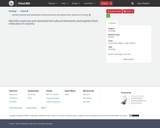
- Subject:
- Social Science
- Sociology
- Material Type:
- Unit of Study
- Provider:
- Ohio Open Ed Collaborative


OER Text materialTheoretical Perspectives on CultureChapter 3, subsection 3.4. According to functionalists, societies need culture to exist. Cultural norms function to support the fluid operation of society, and cultural values guide people in making choices. In addition, culture exists to meet its members’ basic needs. Conflict theorists view social structure as inherently unequal, based on power differentials related to issues like class, gender, race, and age. For a conflict theorist, culture is seen as reinforcing issues of "privilege" for certain groups based upon race, sex, class, etc. Symbolic interactionism is mostly concerned with the face-to-face interactions between members of society. Interactionists see culture as being created and maintained by the ways people interact and in how individuals interpret each other’s actions.

OER Text materialWhat is Culture?Chapter 3, subsection 3.1Culture is defined as shared beliefs, values, and practices, that participants in a society must learn. Sociologically, we examine in what situation and context certain behavior is expected, and in which situations perhaps it is not. Rules are created and enforced by people who interact and share culture. Culture consists of thoughts (expectations about personal space, for example) and tangible things (bus stops, trains, and seating capacity).General Comments:Types of sanction should be clearly identifiedSymbol should be defined in more detail. It should be made clear that symbols, like the American flag, represent something else. Thus, the American flag is not just a piece of cloth; rather, it represents American pride, etc.

OER Text materialElements of CultureChapter 3, subsection 3.2. This learning objective is addressed variously in the chapter. For example, under elements of culture, beliefs, values, idea culture, real culture, norms, etc. are addressed. Values are defined as a culture’s standard for discerning what is good and just in society. Values are deeply embedded and critical for transmitting and teaching a culture’s beliefs. Beliefs are the tenets or convictions that people hold to be true.

OER Text MaterialPop Culture, Subculture, and Cultural ChangeChapter 3, subsection 3.3. Human behavior and worldview are impacted by culture and cultural changes. For example, people are influenced by both high culture and popular culture. Due to the integration of international trade and finance markets (globalization) people have adopted different cultures. Alongside the process of globalization is diffusion, or the spread of material and nonmaterial culture. While globalization refers to the integration of markets, diffusion relates to a similar process in the integration of international cultures.

OER Text materialCultural ChangeChapter 3, subsection 3.3. The concepts of innovation, discovery, and invention are used to explain cultural change. An innovation refers to an object or concept’s initial appearance in society—it is innovative because it is markedly new. There are two types of innovation: discovery and invention. Discoveries make known previously unknown but existing aspects of reality. Inventions result when something new is formed from existing objects or concepts—when things are put together in an entirely new manner.

This objective is lacking in the main text. Please see the recommended reading by the chapter author below in Section 1.

OER Text materialWhat Is Culture? Chapter 3, subsection 3.1. A subsection of this section notes that culture consists of thoughts (expectations about personal space, for example) and tangible things (bus stops, trains, and seating capacity). Then material culture is defined as the objects or belongings of a group of people. Examples of material culture are given as metro passes, bus tokens, automobiles, stores, and the physical structures where people worship. Nonmaterial culture, in contrast, consists of the ideas, attitudes, and beliefs of a society. Material and nonmaterial aspects of culture are linked, and physical objects often symbolize cultural ideas. A metro pass is a material object, but it represents a form of nonmaterial culture, namely, capitalism, and the acceptance of paying for transportation. Clothing, hairstyles, and jewelry are part of material culture, but the appropriateness of wearing certain clothing for specific events reflects nonmaterial culture. It is noted that material and nonmaterial aspects of culture can vary subtly from region to region. As people travel farther afield, moving from different regions to entirely different parts of the world, certain material and nonmaterial aspects of culture become dramatically unfamiliar.


OER Text materialCrime and the LawChapter 7, subsection 7.3. At this subsection various types of crimes – violent crimes, non-violent crimes, street crimes, corporate crimes, and victimless crimes – are compared and contrasted. In addition, primary and secondary deviance are compared and contrasted.

OER Text materialDeviance and ControlChapter 7. In this chapter, several concepts related to deviance are defined and explained. Such concepts include deviance, social control, sanctions, and social order.General Comments on this Section:Data on hate crime is too old – 2009/10Two typos in the chapter at pages 142 AND 144The concept of “Formal sanctions” is used in the chapter. It should be added that formal sanctions are the same as lawsA Table is needed for Merton’s Mode of Adaptation

OER Text materialCrime and the LawChapter 7, subsection 7.3. The society’s solution to the problems of deviance is through the criminal justice system. This involves the use of the police, the courts, and the corrections system. The police are a civil force in charge of enforcing laws and public order at a federal, state, or community level. A court is a system that has the authority to make decisions based on law. The corrections system, more commonly known as the prison system, is charged with supervising individuals who have been arrested, convicted, and sentenced for a criminal offense.

OER Text materialDeviance and ControlChapter 7, subsection 7.1. In this subsection examples are given of behaviors that were considered deviant some time ago but now considered normal, and vice versa. For example, in some states the use of marijuana which was considered deviants is now considered normal. Throughout the chapter, examples of changes in the definition of deviance are given.

OER Text materialTheoretical Perspectives on DevianceChapter 7, subsection 7.2. In this section, functionalism, conflict theory, and symbolic interactionism are used to explain deviance. Theories under functionalism are Émile Durkheim’s The Essential Nature of Deviance, Robert Merton’s Strain Theory, Social Disorganization Theory, and Clifford Shaw and Henry McKay’s Cultural Deviance Theory. Under conflict theory are theories like Karl Marx’s An Unequal System, and C. Wright Mills’ The Power Elite. Under symbolic interactionism are Labeling Theory, Edwin Sutherland’s Differential Association, and Travis Hirschi’s Control Theory.


OER Text Material Understanding and Changing the Social WorldThis section provides a very basic overview of Functionalist (most detailed), Conflict (thin) and Symbolic Interactionist (thin) perspectives on education.

OER Text materialSociology: Understanding and Changing the Social WorldThis section provides a general overview of the history of education in the United States. It covers how education moved from a the exclusive remit of the wealthy to a public education system due to the needs of an industrial economy and a desire to establish and reinforce “American” values over all others.

OER Text materialSociology: Understanding and Changing the Social World, Sections: 16.316.3 reviews the inequalities of educational attainment, the impact education has on income and the influence of education on moral and social attitudes. Sociology: Understanding and Changing the Social World, Sections:, 16.4.1, 16.4.2, and 16.4.516.4.1 reviews how education perpetuates inequality. 16.4.2 reviews the historical and contemporary existence of segregation in schools. 16.4.5 explores why we see social inequalities reflected in the higher education system.

OER Text materialSociology: Understanding and Changing the Social World, Section: 16.3.116.3.1 U.S.-centric exploration of the relationship between gender and education.Sociology: Understanding and Changing the Social World, Section: 16.4.316.4.3 Brief summary of single sex education and the influence on girls ‘and women’s achievement and self-esteem.

OER Text MaterialIntroduction to Sociology 2e, Derived from Introduction to Sociology by OpenStaxThis section of Open Stax describes the differences in educational resources around the world and explores differences in access to education from a global perspective. It highlights the importance of social background in both educational attainment and in access to education. (The main text does not adequately cover this area.)